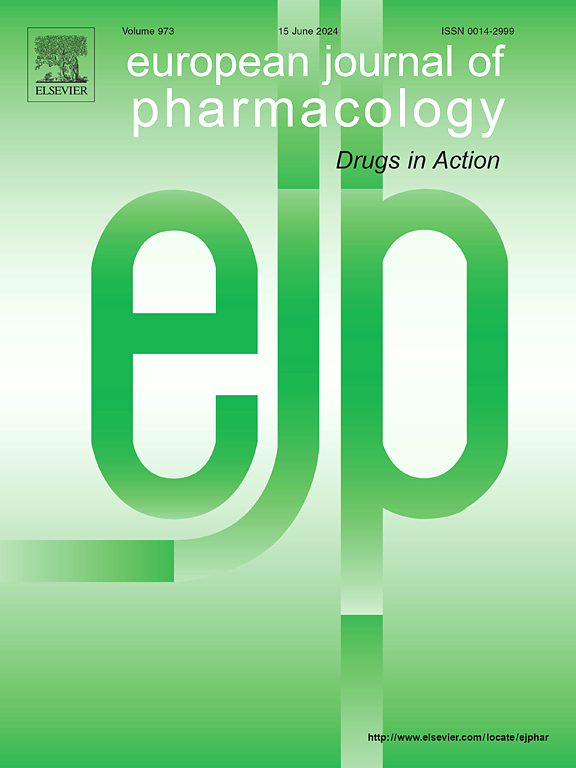Therapeutic effects of finerenone and exenatide on diabetes-induced heart failure: A combined approach targeting inflammation and oxidative stress
IF 4.2
3区 医学
Q1 PHARMACOLOGY & PHARMACY
引用次数: 0
Abstract
Cardiovascular complications, particularly diabetic cardiomyopathy and heart failure, are leading causes of morbidity and mortality in patients with diabetes mellitus. This study aimed to investigate the therapeutic potential of finerenone and exenatide, individually and in combination, in mitigating diabetes-induced cardiac injury. Finerenone, a non-steroidal mineralocorticoid receptor antagonist, exhibits strong anti-fibrotic and anti-inflammatory properties in cardiovascular and renal diseases. Exenatide, a glucagon-like peptide-1 receptor agonist, is recognized for its glucose-lowering effects and additional cardioprotective actions, including antioxidant and anti-inflammatory activities. The combination of these agents was hypothesized to exert synergistic effects by targeting complementary pathological pathways involved in diabetic cardiomyopathy progression.
Type 1 diabetes was induced in rats by a single high-dose streptozotocin injection. Animals were divided into five groups: control, STZ, STZ with finerenone, STZ with exenatide, and STZ with both finerenone and exenatide. Cardiac tissues and serum samples were analyzed for oxidative stress markers (TOS, TAS), inflammatory cytokines (IL-6, IL-1β, TNF-α), and myocardial injury biomarkers (cTnT, cTnI) through RT-qPCR and Western blotting. NRF2 pathway activation was also evaluated to assess antioxidant responses.
STZ-induced diabetic rats showed significant increases in hyperglycemia, inflammation, oxidative stress, and myocardial injury. Treatment with either finerenone or exenatide alone improved several parameters; however, the combination therapy provided the most substantial cardioprotective effects, with marked reductions in oxidative stress and inflammation and enhanced NRF2 expression.
These findings suggest that the combined administration of finerenone and exenatide offers superior protection against diabetes-induced cardiac injury compared to monotherapies, supporting a dual-targeted therapeutic approach for diabetic cardiomyopathy.
芬尼酮和艾塞那肽治疗糖尿病性心力衰竭的疗效:一种针对炎症和氧化应激的联合方法。
心血管并发症,特别是糖尿病性心肌病和心力衰竭,是糖尿病患者发病和死亡的主要原因。本研究旨在探讨芬尼酮和艾塞那肽单独和联合使用在减轻糖尿病引起的心脏损伤方面的治疗潜力。芬芬烯酮是一种非甾体矿物皮质激素受体拮抗剂,在心血管和肾脏疾病中表现出很强的抗纤维化和抗炎特性。艾塞那肽是一种胰高血糖素样肽-1受体激动剂,被认为具有降血糖作用和额外的心脏保护作用,包括抗氧化和抗炎活性。假设这些药物的组合通过靶向与糖尿病心肌病进展相关的互补病理途径发挥协同作用。单次注射高剂量链脲佐菌素诱导大鼠1型糖尿病。动物分为5组:对照组、STZ组、芬芬烯酮组、艾塞那肽组、芬芬烯酮和艾塞那肽联合组。通过RT-qPCR和Western blotting分析心脏组织和血清样本的氧化应激标志物(TOS、TAS)、炎症因子(IL-6、IL-1β、TNF-α)和心肌损伤生物标志物(cTnT、cTnI)。NRF2通路激活也被评估以评估抗氧化反应。stz诱导的糖尿病大鼠高血糖、炎症、氧化应激、心肌损伤明显增加。芬尼酮或艾塞那肽单独治疗改善了几个参数;然而,联合治疗提供了最显著的心脏保护作用,氧化应激和炎症显著减少,NRF2表达增强。这些研究结果表明,与单一治疗相比,芬尼酮和艾塞那肽联合给药对糖尿病引起的心脏损伤具有更好的保护作用,支持糖尿病心肌病的双靶向治疗方法。
本文章由计算机程序翻译,如有差异,请以英文原文为准。
求助全文
约1分钟内获得全文
求助全文
来源期刊
CiteScore
9.00
自引率
0.00%
发文量
572
审稿时长
34 days
期刊介绍:
The European Journal of Pharmacology publishes research papers covering all aspects of experimental pharmacology with focus on the mechanism of action of structurally identified compounds affecting biological systems.
The scope includes:
Behavioural pharmacology
Neuropharmacology and analgesia
Cardiovascular pharmacology
Pulmonary, gastrointestinal and urogenital pharmacology
Endocrine pharmacology
Immunopharmacology and inflammation
Molecular and cellular pharmacology
Regenerative pharmacology
Biologicals and biotherapeutics
Translational pharmacology
Nutriceutical pharmacology.

 求助内容:
求助内容: 应助结果提醒方式:
应助结果提醒方式:


